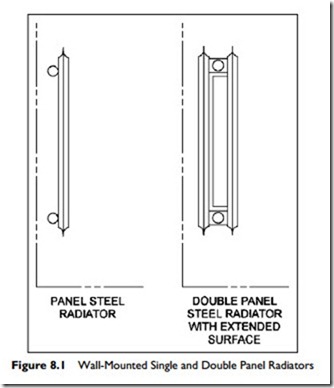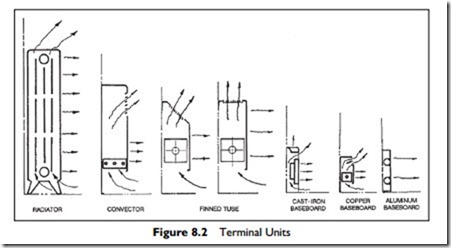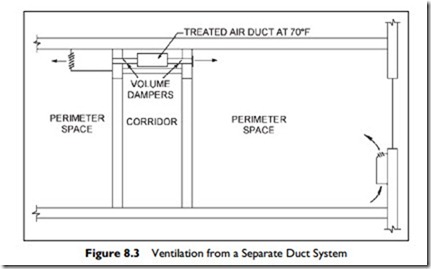Natural Convection and Low Temperature Radiation Heating Systems
The very simplest water heating systems consist of pipes with hot water flowing through them. The output from a bare pipe is generally too low to be effective, so an extended surface is used to dissipate more heat. There is a
vast array of heat emitters. A small selection of types is shown in Figures 8.1 and 8.2. Note that there are regional variations both in styles available, and in their popularity. For example, the hot-water panel-radiator is popular in Europe for both domestic and commercial heating systems. In North America, variations on the finned-tube radiator are most popular. The panel radiator shown in Figure 8.1 is manufactured in a range of heights, from 8 to 36 inches, and in lengths up to 8 feet.
The radiator emits heat by both radiation and convection. The unit temperature is typically below 220°F and is considered ‘low temperature’ as far as radiation is concerned. In the final chapter of this book, we will review higher temperature radiant heaters and their specific characteristics and uses.
Starting at the left, we see the classic sectional radiator. Originally made from cast iron, there are now pressed-steel versions being manufactured. All of these terminal units are closed systems that heat the room-air as it contacts the heated coils.
The convector is a coil, mounted horizontally, at the bottom of a casing. The casing is open at the bottom and has louvers near, or in, the top. The coil heats the air, which becomes less dense and rises up the unit. The column of warm, less dense air causes a continuous flow over the coil, convecting heat from the unit. This warm air, rising in an enclosure, is called the “chimney effect,” since it is most often experienced in the draft up a chimney. The taller the chimney, or in this case the taller the casing, the greater the draft through the unit, and the higher the output.
Convectors are typically used where medium output is required in a short length of wall.
The finned tube is similar to the convector, but the unit is long, and typically, runs around the perimeter of the building. The hot water enters one end and cools as it flows through the finned tube. If the fins on the tube are at a constant spacing, the output will fall as the water cools down. This drop in output can be offset, to some extent, by having sections of pipe with no fins at the hot end and also by changing the fin spacing along the tube.
Since the output occurs along the length of the unit, it nicely balances the heat loss through walls and windows, providing a thermally comfortable space without downdrafts. The construction is normally quite lightweight though, so if the finned tube is to be installed where someone may sit or stand upon it, a more robust version should be chosen. Some designs permit limited, manual adjustment to the output, accomplished by setting a flap damper in the unit.
The copper baseboard radiator is a small residential version of the finned tube. Cast iron baseboards have the advantage of being robust, however low output and substantial material make them less popular nowadays. Finally, the aluminum baseboard unit consists of pipes bonded to an aluminum sheet that emits almost all its heat by radiation, with a consequently low output.
These water heaters can all be controlled in two ways:
By varying the water flow
By varying the water supply temperature.
Varying the Water Flow
Local zone control can be achieved by throttling the water flow. The simplest way to achieve this is with a self-contained control valve, mounted on the pipe. This valve contains a capsule of material that experiences large changes in volume, based on room temperature. As the temperature rises, the material expands and drives the valve closed. The valve settings are not marked with temperatures and it is a matter of trial-and-error to find the comfortable set- ting. A better, but more expensive, method of control is a wall thermostat and water control valve.
Control by modulating, or adjusting, the water flow works best when the load is high and the flow is high. For example, a finned tube, operating at low load with a low flow, will have almost full output just at the entry point of the water, but the water cools down to provide no output of heat at the far end. Both this issue and unnecessary pipe losses can be greatly reduced by modulating the water temperature.
Varying the Water Temperature
The heat loss through a wall or window is proportional to the temperature difference across the wall or window. Thus, one can arrange a control system to increase the water temperature as the outside temperature falls, so that the heat output from the water will increase in step with the increase in heating load. This control system is called outdoor reset. In a simple outdoor reset system, the water flow temperature might be set to 180°F at the anticipated minimum outside design temperature, dropping to 70°F at an outside temperature of 70°F.
The output from the heater is not exactly linearly proportional to the water temperature. The actual output rises proportionately faster, the higher the temperature difference between heater and space. This disparity does not matter if the zone thermostat controls the zone temperature. Outdoor reset Minimizes uncontrolled heat loss from distribution piping.
Improves zone control by keeping the zone flow control valves operating near full capacity.
Achieves a more even temperature in the heaters, since the flow stays up.
Together, outdoor reset of water supply temperature and zone throttling provide excellent temperature control of hydronic systems.
Meeting Ventilation Requirements
These hydronic heating systems do not provide any ventilation air from out- side. When water systems are in use, ventilation requirements can be met in one of 3 ways:
Open windows
Window air conditioners
Separate ventilation systems with optional cooling.
Open Windows: Water systems are often used with occupant-controlled windows (opening windows) where the room depth is limited and the out- door temperatures make it practical to open windows.
Window Air conditioners: One step up from heating and opening windows is heating and the window air-conditioner.
Separate ventilation systems with optional cooling: The alternative is to install a separate system to provide ventilation and, if needed, cooling. This is a very common design in cooler climates for two reasons. First, the water heat- ing around the perimeter is very comfortable and, second, it means that the air system can be shut off when the building is unoccupied, leaving the heating operating and keeping the building warm. Many office buildings operate only five days a week, twelve hours a day, so the air system can be turned off for
108 hours and only run 60 hours a week, saving 64% of the running hours of the ventilation system. Figure 8.3 shows perimeter fan coils which provide heating and cooling plus a ventilation system using the corridor ceiling space for the ventilation supply duct.
The control of the hydronic heating system and ventilation/cooling system should be coordinated to avoid energy waste. Let us assume for a moment that each system has its own thermostat in each zone. If the heating thermostat is set warmer than the cooling thermostat, both systems will increase output until one is running flat out. Therefore, it is important to have a single thermostat controlling both the water heating system and the air-conditioning system. Ideally, this thermostat will have a dead band, which is a temperature range of, say, 2°F between turning off the cooling and turning on the heating.
In hot moist climates, the primary ventilation air must be supplied with a low moisture content to minimize mold problems. In addition, it is advantageous to keep the building pressure positive with respect to outside, so as to minimize local infiltration that might cause excessive moisture inside.


